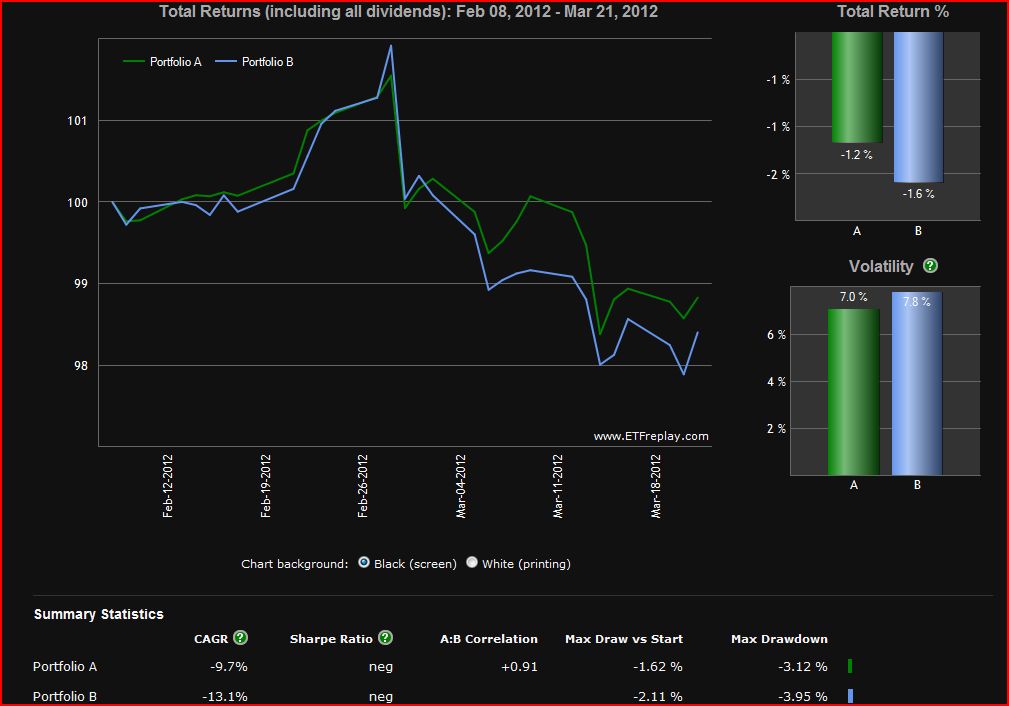In February Global X launched a Permanent Portfolio ETF, symbol PERM. The fund’s fact sheet states it “seeks to provide investment results that correspond generally to the price and yield performance, before fees and expenses, of the Solactive Permanent Index.”
The Solactive Permanent Index “tracks the performance of four asset class categories that are designed to perform differently across different economic environments, as defined by the index provider. On each rebalance, the Underlying Index allocates 25% each to four asset class categories: Stocks, U.S. Treasury Bonds (Long-Term), U.S. Treasury Bonds (Short-Term), and Gold and Silver.”
This allocation closely correlates to Harry Browne’s proposed allocation in his 1998 Fail-Safe Investing: Lifelong Financial Security in 30 Minutes. Browne proposed an equal-weight portfolio of stocks, long-term bonds, cash, and gold.
Today an investor could create this portfolio using as little as four ETFs: SPY (SPDR S&P 500 ETF), TLT (iShares Barclays 20+ Year Treasury), SHY (iShares Barclays 1-3 Year Treasury Bond Fund), and GLD (SPDR Gold Trust). I recently posted some historical results on this allocation here.
How closely has PERM correlated to the 4-ETF Browne Permanent Portfolio referenced above?PERM has a very short trading history, so these results are very preliminary.However, this type of comparison could be useful to periodically monitor for investors weighing an all-in-one Permanent Portolio solution (PERM) versus a self-managed, multi-ETF Permanent Portfolio.
As expected, an equal weight portfolio of SPY/TLT/SHY/GLD (Portfolio A) has been highly correlated with PERM (Portfolio B) since February 8th, 2012. The results using ETF Replay are below. It is important to note that PERM has not yet paid a dividend, while SPY, SHY, and TLT have all paid dividends since February 8th. These dividends are reflected in the returns for Portfolio A, which helps explain the small out-performance to date. I will revisit the comparative results once PERM has paid a dividend, which will give us a more accurate total return comparison for both portfolios:
- English (UK)
- English (India)
- English (Canada)
- English (Australia)
- English (South Africa)
- English (Philippines)
- English (Nigeria)
- Deutsch
- Español (España)
- Español (México)
- Français
- Italiano
- Nederlands
- Português (Portugal)
- Polski
- Português (Brasil)
- Русский
- Türkçe
- العربية
- Ελληνικά
- Svenska
- Suomi
- עברית
- 日本語
- 한국어
- 简体中文
- 繁體中文
- Bahasa Indonesia
- Bahasa Melayu
- ไทย
- Tiếng Việt
- हिंदी
Permanent Portfolio ETF Smack-Down
Latest comments
Loading next article…
Install Our App
Risk Disclosure: Trading in financial instruments and/or cryptocurrencies involves high risks including the risk of losing some, or all, of your investment amount, and may not be suitable for all investors. Prices of cryptocurrencies are extremely volatile and may be affected by external factors such as financial, regulatory or political events. Trading on margin increases the financial risks.
Before deciding to trade in financial instrument or cryptocurrencies you should be fully informed of the risks and costs associated with trading the financial markets, carefully consider your investment objectives, level of experience, and risk appetite, and seek professional advice where needed.
Fusion Media would like to remind you that the data contained in this website is not necessarily real-time nor accurate. The data and prices on the website are not necessarily provided by any market or exchange, but may be provided by market makers, and so prices may not be accurate and may differ from the actual price at any given market, meaning prices are indicative and not appropriate for trading purposes. Fusion Media and any provider of the data contained in this website will not accept liability for any loss or damage as a result of your trading, or your reliance on the information contained within this website.
It is prohibited to use, store, reproduce, display, modify, transmit or distribute the data contained in this website without the explicit prior written permission of Fusion Media and/or the data provider. All intellectual property rights are reserved by the providers and/or the exchange providing the data contained in this website.
Fusion Media may be compensated by the advertisers that appear on the website, based on your interaction with the advertisements or advertisers.
Before deciding to trade in financial instrument or cryptocurrencies you should be fully informed of the risks and costs associated with trading the financial markets, carefully consider your investment objectives, level of experience, and risk appetite, and seek professional advice where needed.
Fusion Media would like to remind you that the data contained in this website is not necessarily real-time nor accurate. The data and prices on the website are not necessarily provided by any market or exchange, but may be provided by market makers, and so prices may not be accurate and may differ from the actual price at any given market, meaning prices are indicative and not appropriate for trading purposes. Fusion Media and any provider of the data contained in this website will not accept liability for any loss or damage as a result of your trading, or your reliance on the information contained within this website.
It is prohibited to use, store, reproduce, display, modify, transmit or distribute the data contained in this website without the explicit prior written permission of Fusion Media and/or the data provider. All intellectual property rights are reserved by the providers and/or the exchange providing the data contained in this website.
Fusion Media may be compensated by the advertisers that appear on the website, based on your interaction with the advertisements or advertisers.
© 2007-2025 - Fusion Media Limited. All Rights Reserved.
